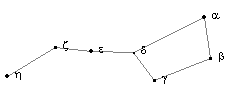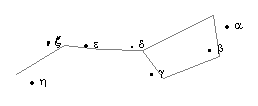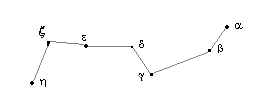 Your Sky Help: Proper Motion
Your Sky Help: Proper Motion Your Sky Help: Proper Motion
Your Sky Help: Proper MotionWe frequently speak of “the fixed stars” as the one constant in a a sky where everything else is forever changing. But even the “fixed stars” move, albeit slowly compared to a human life span. When you look at the sky, it's easy to think of it, as the ancients did, as a great bowl resting on the horizon. What's difficult to fully grasp is the immense depth of the sky. With your unaided eye, you can see objects as close as a couple of light seconds (the Moon) or as far away as a couple million light years (the great galaxy in Andromeda, M31). All the stars you see in the sky are members of our own galaxy, the Milky Way. Each moves in its own orbit around the galaxy: the Sun takes about 225 million years to complete each circuit. Compared to anything in everyday human experience, the stars are zipping right along: the rate of motion relative to the Sun and Earth is given in kilometers per second, with values for some stars over 100.
It is the immense distance of the stars which keeps their motion from being apparent over short intervals of time. Even motion of 50 kilometers per second which, over a year causes a star to move more than one and a half thousand million kilometers—farther than Saturn is from the Sun, isn't going to be particularly apparent when you're looking at it from a couple of hundred light years away. (A light year is almost 10 million million) kilometers. Seen from a distance of two hundred light years away, or two thousand million million kilometers, motion of a billion and a half kilometers changes the observed position of a star only 0.15 arc seconds (and that's assuming all the motion is at orthogonal to the line of sight; to the extent the motion is toward or away from the Earth, the apparent motion will be less). Even moving at 50 kilometers per second at a right angle to our line of sight, more than 12,000 years will pass before the star's position in our sky changes by the diameter of the full Moon. The apparent motion of most stars seen from Earth is a small fraction of that in this example.

Still, even minuscule motion mounts over millennia. The constellations didn't look the same to our distant ancestors in the Stone Age; one wonders what figures they traced in that ancient sky, and what legends they invented to explain it all. The motion that brought the “fixed stars” to where we see them today continues apace. Who can imagine what our descendants will have learned and done five hundred centuries from now? And yet even though that distant future is unknowable and unimaginable to us, we can chart the sky they will see when they gaze upward from this home planet of our species.

Already, the stars are drifting into noticeably different patterns. (I've kept the outline of the Big Dipper as it appears today, so you can better see how the stars have moved from their original positions.) What will the observers of that strange sky expect of the future before them, equally remote as that still distant yet well remembered milestone when life took its first step from the planet where it was born into a larger universe? And the sky a tenth of a million years from today will have changed into this:

Now the stars have really begun to assume new forms—the outlines we draw in our star maps don't connect the dots in the sky any more. Let's redraw this constellation, which will still be as bright in Northern skies a thousand centuries from now.

Some dipper! The handle has turned into an inverted bowl, and α and β, the stars we teach our children to use as “The Pointers” to Polaris don't point anywhere in particular, certainly not toward Polaris which, for that matter, won't be anywhere near the North pole by then (due to precession, not its own motion, which appears rather small as seen from Earth, about 680 light years away).
Astronomers call this slow-motion shuffling of the stars proper motion, not in the sense that other forms of motion (the daily, seasonal, and precessional changes we see in the sky) are in any way “improper”, but using “proper” to signify that unlike those other apparent motions which simply reflect our vantage point on the moving Earth, proper motion results from the stars' own motion in space. Proper motion is “real motion”; all the other, more dramatic, “motion” of the stars is only “apparent motion”, due to the rotation of the Earth, motion of the Earth in its orbit, and a host of other, more subtle, effects (for example, aberration due to the finite speed of light).
Remember that proper motion is still “apparent” in the sense that we measure it based on how quickly the star moves in our sky. A star with a large proper motion is not necessarily moving unusually swiftly in space; in most cases it simply seems to move quickly because it's nearby and hence the baseline of the observation is short. The star with the greatest known proper motion is a dim star called Barnard's Star: it's only 5.91 light years away and moving unusually rapidly as well, so we see it move 10.3 arc seconds per year. At this rate it takes only 180 years to move the diameter of the full Moon as seen from Earth. Most stars with large proper motion are undistinguished nearby faint red stars. Nature adores the mediocre, and the vast majority of stars are dim red dwarves—the stellar equivalent of 25 Watt bulbs. Thus it shouldn't be surprising that most of the nearby stars are too faint to see. Naked-eye stars with large proper motion include:
| HD | Star name | Magnitude | Distance (light years) | Proper motion (arcseconds/year) |
|---|---|---|---|---|
| 201091 | 61 Cygni | 5.20 | 11.4 | 5.28 |
| 209100 | ε Indi | 4.69 | 11.8 | 4.70 |
| 26965 | o2 Eridani | 4.43 | 16.5 | 4.09 |
| 6582 | μ CassiopeiŠ | 5.17 | 24.6 | 3.78 |
| 12860 | α Centauri | −0.01 | 4.4 | 3.71 |
| 20794 | 82 G. Eridani | 4.26 | 19.8 | 3.12 |
| 124897 | Arcturus | −0.05 | 36.7 | 2.28 |
Even among this crop, only α Centauri and Arcturus are genuinely bright stars.
Return to Your Sky Other Help| by John Walker |
|